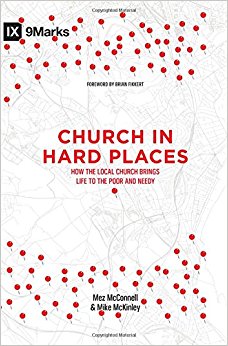 Church in Hard Places (CIHP) is a book written by Mez McConnell and Mike McKinley. The subtitle helpfully articulates the burden the book aims to make clear: How the local church brings life to the poor and needy.
Church in Hard Places (CIHP) is a book written by Mez McConnell and Mike McKinley. The subtitle helpfully articulates the burden the book aims to make clear: How the local church brings life to the poor and needy.
Ministry to the poor is nothing new to Mez. Prior to Scotland, he was involved in church planting in one of Brazil’s poorest cities. He came to Scotland to oversee the revitalization of Niddrie Community Church. Mez is desperate to see this kind of work modeled and magnified through Scotland’s housing schemes and the rest of the UK. In addition to pastoring he is the director of 20schemes, a church planting and revitalization initiative among Scotland’s poorest. Mike McKinley (co-author) is lead pastor at Sterling Park Baptist Church, a revitalization effort in Virginia. Sterling Park Baptist has found fruitful ministry inroads among their neighborhood’s homeless, the working poor, and illegal immigrants. Mez and McKinley pastor in completely different contexts and yet speak with first hand experience as those doing the work of church in hard places.
If Mez and Mike were asked, “Why did you write this CIHP? What does this emphasis on the local church have to do with reaching people in hard places?” They would respond, “The local church is God’s primary evangelism strategy.” (87)
In other words, “The church is at the heart of God’s saving plan. His love does not rest on a multitude of isolated individuals, but it calls out and creates a people who can now be called ‘God’s people’ 1 Pet. 2:9-10. . . . God has designed the church to be the vehicle that takes his saving message to the world.” (31)
So wait a minute, if I am looking for help to reach the toughest, poorest communities you are going to give me a book on ecclesiology?
Yes.
This is what stood out to me when I visited Niddrie earlier this year. The church was hosting a “Church in Hard Places Weekender.” This is a conference for pastors and church leaders who desire to engage in faithful ministry in a “hard place.” It covered topics such as evangelism, discipleship, church membership and discipline, counseling, and leadership development. This premise pivots on the fact that the way to transform the poorest communities is through the ministry of a vibrant healthy local church equipped with the gospel of Jesus, empowered by the Spirit, and obediently carrying out the Great Commission.
Getting practical consider the following:
- Does the culture have authority issues? “A culture that despises any kind of authority needs to see healthy models of leadership and submission. And the best place for people to see this modeled is in the local church.” (92)
- Are people entangled in destructive sin? “Healthy practices of membership and discipline play a crucial role in cultivating and protecting the distinctiveness of a church.” (128)
- Is there anger, hostility, and strife? “A local church is a community of the reconciled—those reconciled to God and to each other.” (31)
- Are they steeped in false teaching and lostness? “It is hard to reconcile this picture of the church’s evangelistic task with the claim that our witness should be driven primarily by acts of love and mercy toward the need. The fact is, the world can watch Christians ladle soup or paint over graffiti for a thousand years, and they’ll never come to the conclusion that Jesus died for their sins and rose again. We must open our mouths and speak the content of the gospel to the world, or no one will be saved.” (63)
In addition to teaching the necessary elements of a healthy church, CIHP helps leaders think through poverty in a similar vein of When Helping Hurts by Steve Corbett and Brian Fikkert (who also wrote the foreword).
Feeding a lazy man simply encourages his sin and enables him to avoid the consequences of his actions. (177)
Churches that are content to merely provide material assistance to needy people are missing an opportunity to minister to them at a deeper level. . . . The one unique thing that a local church has to offer people mired in poverty is the gospel of Jesus Christ. Other things may be very important, but they are still secondary.
Overall the book offers a vision for doing ministry in poor communities. Young people considering missions, church planters in urban as well as rural settings, pastors in revitalization situations, and hungry church members will be encouraged by reading. If you are looking for innovative ways to reach the poor you might be disappointed. But this is exactly the point. They argue that planting, revitalizing, and helping existing churches be faithful is God’s plan to reach all communities—not just the poor. Any fresh insight here is no new trendy practice but merely advice from the hard-fought situations (successes and failures) Mez and Mike have experienced while doing ordinary church in hard places. So in addition to chapters on the gospel, sound doctrine, evangelism, preaching, and membership you find interspersed counsel for ministering to people in cycles of poverty, how to work with and empower new converts, speak in culturally sensitive ways, spot and train unlikely leaders, and develop culturally relevant models of theological training.
Mez and Mike leave us with a charge to count the cost:
In the end, the question is not whether discipleship will come with a cost (it will), but how we can best invest our lives in Christ’s kingdom. (194)
For some of us this might mean rethinking where and how we are going to do ministry. I came back from Scotland instructed, encouraged, challenged, prayerful, and hopeful. The Lord is kindling a little fire among Scotland’s poorest. May he use CIHP to challenge, equip, and mobilize pastors and churches in the United States to do the same.
Pick up Church in Hard Places at a discounted price at Amazon.
Note: If you are doing ministry in a poor community consider connecting with The Church in Hard Places Collaborative. They seek to equip, resource, and encourage indigenous leaders in poor communities to build healthy churches. Reach out to them at www.ChurchInHardPlaces.com to find out more.


















